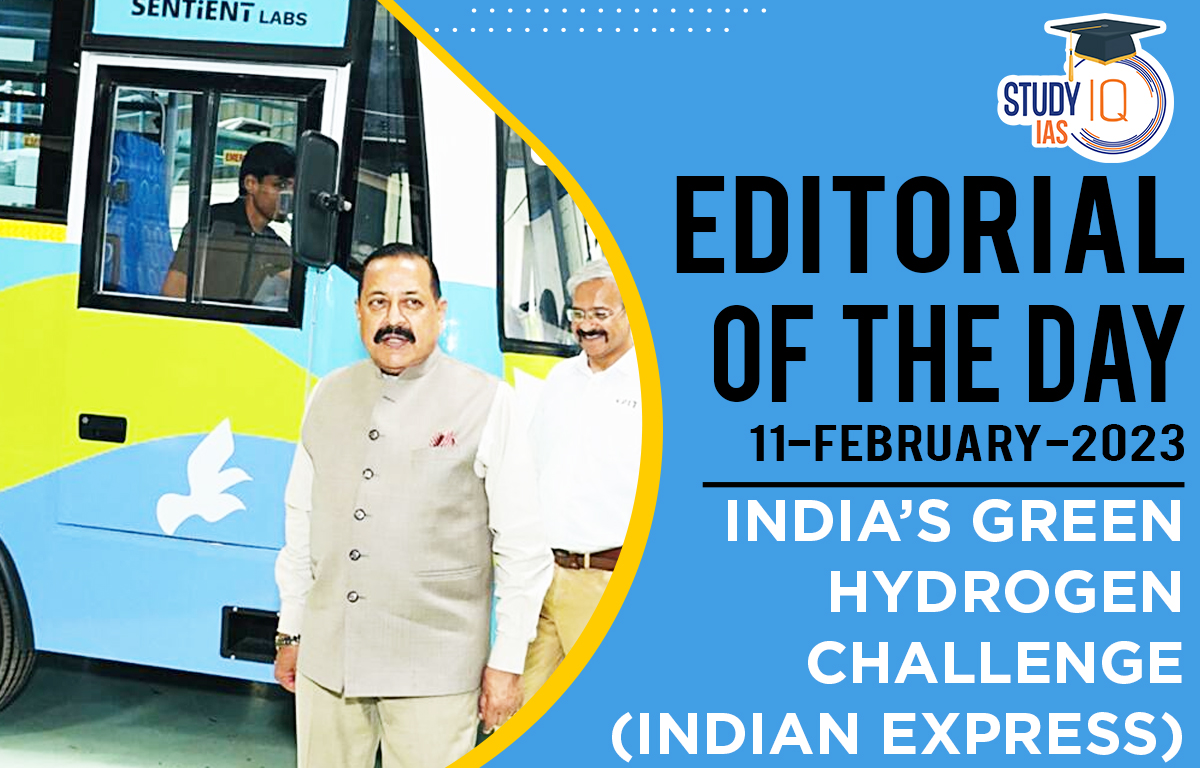Table of Contents
The Prime Minister of India announced the National Hydrogen Mission to make the country a production and export hub of green hydrogen, during the 75th Independence Day speech.
However, there are many critical challenges that must be examined to help design appropriate pathways to realise this vision.
Hydrogen Energy
- Hydrogen has been given colour spectrum (green, blue, grey, black, and brown) depending on the ability to totally avoid or capture the greenhouse gases emitted in the process.
- Green hydrogen: Hydrogen is produced through water electrolysis. When the electricity used in the water electrolysis is obtained from renewables, it is classified as green hydrogen.
- Mission: The National Hydrogen Mission aimed at producing 5 MMT per annum with an associated renewable energy capacity addition of about 125 GW by 2030.
- Usage: Green hydrogen has the potential to reduce carbonization of the energy sector and the use of energy in end-use sectors such as transport, buildings and industry.
- Benefits: Green hydrogen has potential to generate savings to the tune of $12.5 billion from fuel imports, avoid 50 MMTs of annual CO2 emissions, fresh investments to the tune of $100 billion in the sector, and generate 6,00,000 green jobs.
The challenges to producing and using green hydrogen can be classified into 4Es — electrolyser, energy source, end use and endogenous resources:
- Electrolyser Challenge: The global manufacturing capacity of electrolysers is at 8 GW/year. In case India was to achieve its 2030 target, it requires 60-100 GW of electrolyser capacity, which amounts to almost 12 times the current global production capacity.
- The inability to access critical minerals such as nickel, platinum metals and rare earth metals such as lanthanum, yttrium and zirconium could hinder electrolyser manufacturing capability in India. India has limited processing capabilities in these minerals.
- For producing electrolysers, India would need to set up large-scale manufacturing, build expertise and secure geo-political partnerships for the procurement of critical minerals, while competing with other global players.
- Energy source challenge: According to studies, a completely efficient electrolysis system would need 39 kWh of electricity to obtain 1 kg of hydrogen.
- India requires a capacity of 125 GW of renewable energy to meet its green hydrogen 2030 targets, which would be additions to the already proposed targets of 500 GW of renewable energy capacity.
- There would be a requirement to enhance the transmission capacity, including smooth facilitation of cross-border exchange of power between states.
- End-use challenge: The current demand for hydrogen is mainly from the chemical industry to produce ammonia for fertilisers, followed by refining for hydrocracking and the desulphurisation of fuels.
- It is a source of heat for industry, especially in sectors such as steel, cement and aluminium production. It can be used as fuel in heavy-duty vehicles, aviation and shipping.
- Hydrogen is a highly combustible and volatile element. Using it for the same purpose as electricity would not make technical or economic sense, as it would increase the cost of storage and transportation.
- The conversion efficiency from one form of energy carrier to another for application will determine the scale of green hydrogen’s applicability in future.
- Endogenous resources challenge: Producing one kg of hydrogen by water electrolysis requires around nine litres of demineralised water.
- India requires approximately 50 billion litres of water supply for producing green hydrogen, which would be an additional burden on the country’s depleted resources.
- Desalination plants will not be feasible as they will not only increase the physical footprint of the required infrastructure but also potentially add to the competition for land use, impact biodiversity and create other challenges.
- This would mean that proposed green hydrogen hubs have to strike a fine balance between being renewable energy-rich, water resource-rich and being close to hydrogen demand (end-use) centres, while keeping the additional costs minimum.
Conclusion
- According to IRENA, hydrogen and its derivatives will account for 12 per cent of global final energy consumption by 2050, with two-thirds obtained from green hydrogen.
- The global levelised cost of green hydrogen production ranges between Rs 250-650/kg while India aims to keep it in the range of Rs 100-150/kg by 2030.
- This would mean India has to address all the above challenges in a record time as well as coordinate across multiple institutional bodies, both public and private.


 Daily Quiz 01 July 2025
Daily Quiz 01 July 2025
 China, Pakistan and Bangladesh Trilatera...
China, Pakistan and Bangladesh Trilatera...
 US Pulls Funding from GAVI-Global Vaccin...
US Pulls Funding from GAVI-Global Vaccin...





















